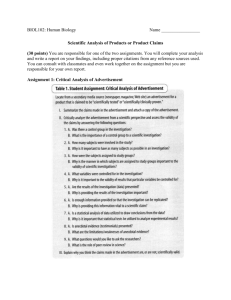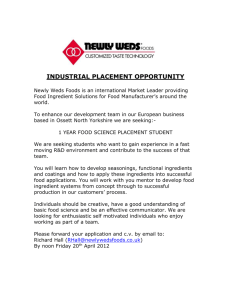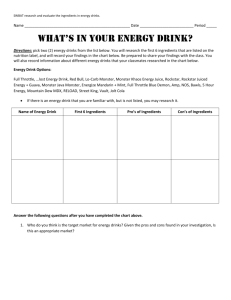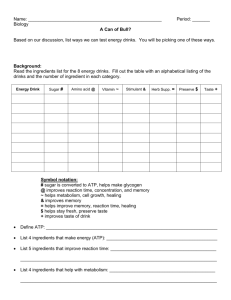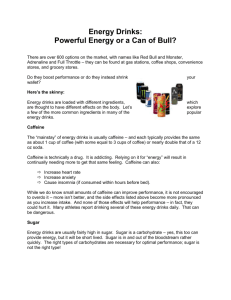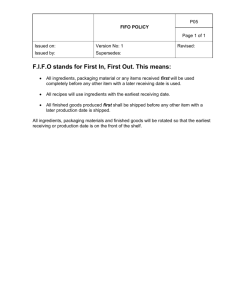14-16 BizStr Dec.indd
advertisement
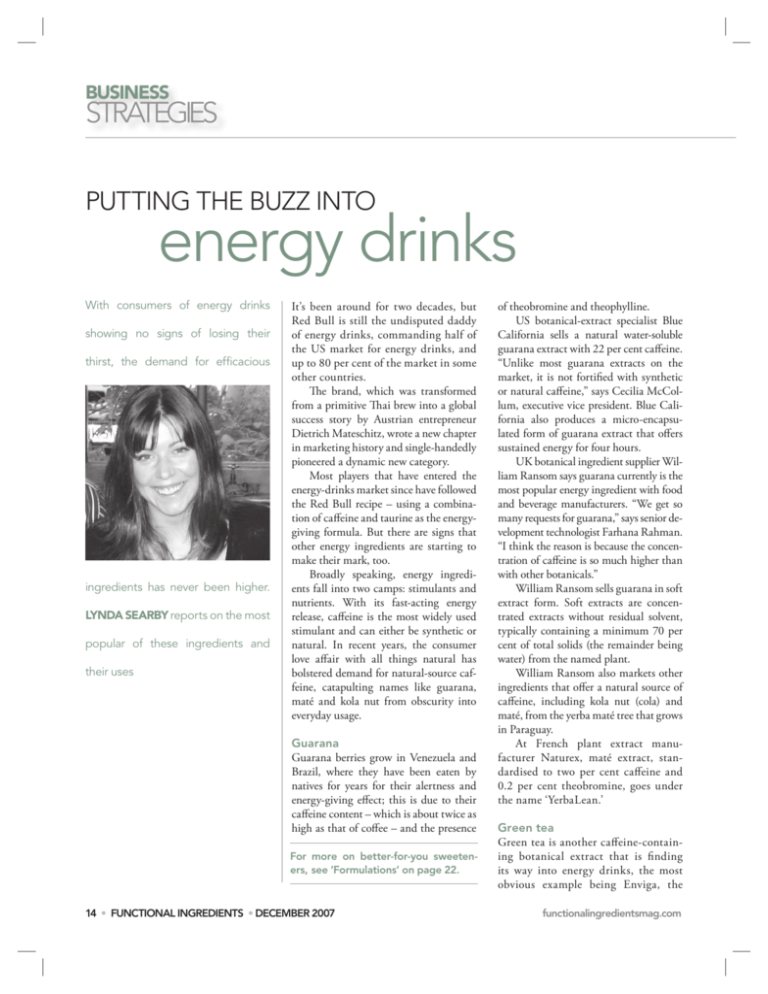
BUSINESS STRATEGIES PUTTING THE BUZZ INTO energy drinks With consumers of energy drinks showing no signs of losing their thirst, the demand for efficacious ingredients has never been higher. LYNDA SEARBY reports on the most popular of these ingredients and their uses It’s been around for two decades, but Red Bull is still the undisputed daddy of energy drinks, commanding half of the US market for energy drinks, and up to 80 per cent of the market in some other countries. The brand, which was transformed from a primitive Thai brew into a global success story by Austrian entrepreneur Dietrich Mateschitz, wrote a new chapter in marketing history and single-handedly pioneered a dynamic new category. Most players that have entered the energy-drinks market since have followed the Red Bull recipe – using a combination of caffeine and taurine as the energygiving formula. But there are signs that other energy ingredients are starting to make their mark, too. Broadly speaking, energy ingredients fall into two camps: stimulants and nutrients. With its fast-acting energy release, caffeine is the most widely used stimulant and can either be synthetic or natural. In recent years, the consumer love affair with all things natural has bolstered demand for natural-source caffeine, catapulting names like guarana, maté and kola nut from obscurity into everyday usage. Guarana Guarana berries grow in Venezuela and Brazil, where they have been eaten by natives for years for their alertness and energy-giving effect; this is due to their caffeine content – which is about twice as high as that of coffee – and the presence For more on better-for-you sweeteners, see ‘Formulations’ on page 22. 14 • FUNCTIONAL INGREDIENTS • DECEMBER 2007 of theobromine and theophylline. US botanical-extract specialist Blue California sells a natural water-soluble guarana extract with 22 per cent caffeine. “Unlike most guarana extracts on the market, it is not fortified with synthetic or natural caffeine,” says Cecilia McCollum, executive vice president. Blue California also produces a micro-encapsulated form of guarana extract that offers sustained energy for four hours. UK botanical ingredient supplier William Ransom says guarana currently is the most popular energy ingredient with food and beverage manufacturers. “We get so many requests for guarana,” says senior development technologist Farhana Rahman. “I think the reason is because the concentration of caffeine is so much higher than with other botanicals.” William Ransom sells guarana in soft extract form. Soft extracts are concentrated extracts without residual solvent, typically containing a minimum 70 per cent of total solids (the remainder being water) from the named plant. William Ransom also markets other ingredients that offer a natural source of caffeine, including kola nut (cola) and maté, from the yerba maté tree that grows in Paraguay. At French plant extract manufacturer Naturex, maté extract, standardised to two per cent caffeine and 0.2 per cent theobromine, goes under the name ‘YerbaLean.’ Green tea Green tea is another caffeine-containing botanical extract that is fi nding its way into energy drinks, the most obvious example being Enviga, the functionalingredientsmag.com energy drink marketed by Coca Cola and Nestlé. Besides its caffeine content, which is about half that of black tea, green tea is rich in antioxidants, and specifically EGCG (epigallocatechin gallate), an antioxidant that ‘burns calories.’ Th is claim is backed by studies that have shown that when EGCG and caffeine are present at the levels comparable to that in three cans of Enviga, people can experience an average increase in calorie burning of 60-100 calories. The same chemical component in green tea is also thought to contribute to heart health. A Japanese study earlier this year, for example, found that adults drinking five or more cups of green tea daily were 16 per cent less likely to die from a range of illnesses, particularly heart disease, than those only drinking one cup per day. The growing body of evidence in support of green tea is likely to stand it in good stead going forward, as energydrink makers eager to break out of the ‘Red Bull mould’ look to develop drinks that deliver not only an energy boost, but also some additional nutritional or health benefit, a trend that can already be observed in markets such as the UK. “Many of the newer drinks come with added vitamins or some other functionality - they are not just energy drinks. I think there has been a slight shift away from the straightforward energy drink of five or six years ago,” says Rahman. This observation is backed up by Lorraine Bailey, nutrition manager at UK health ingredient solutions provider Naturis, who says: “The consumer is learning more about energy products, so we are seeing demand for ‘better’ energy drinks, and products that offer health benefits. There is a definite place for the caffeine-loaded drink, but there is a growing need in the market for drinks that, besides energy, offer the consumer a tangible health benefit.” While well-researched ingredients will benefit from this trend, ingredients that rely on shakier evidence for their infunctionalingredientsmag.com clusion on energy-drink labels might find themselves out in the cold, particularly in Europe, where new legislation designed to crack down on dubious or unsubstantiated claims has just come into force. B5 particularly important for energy production and oxygen utilisation. Most energy drinks include a combination of B vitamins,” says DSM’s global business manager Alan Abolencia. Ginseng One botanical extract that may suffer is ginseng, as although new age medical experts hark back to its use in Chinese medicine 2,000 years ago, the jury is still out on whether it actually has any effect on energy levels. This is probably the reason why although ginseng is often featured in energy drinks, it is rarely positioned as the primary active ingredient. L-carnitine The amino acid L-carnitine also assists energy generation by increasing the oxidation of fatty acids. Coenzyme Q10 Besides caffeine-containing ingredients, the other group of energy ingredients is energy nutrients, or ingredients that assist with the body’s energy production process. Coenzyme Q10 is one such ingredient. Found in the mitochondria, co-Q10 is required for all cellular metabolism. Deficiencies in co-Q10 can lead to inefficient energy metabolism and low energy or fatigue and muscle soreness. Blue California markets a micro-encapsulated, water-soluble form of coQ10, which, according to a study carried out in Japan, is five times more bioavail- Photo courtesy Blue California able than regular co-Q10. DSM Nutritional Products brands its “The main function of L-carnitine co-Q10 ingredient ALL-Q. ALL-Q uses is the transport of activated long-chain DSM’s Actilease beadlet technology for fatty acids from the cytosol into the miimproved stability and bioavailability. tochondria, where their oxidation takes DSM also counts the B complex vitaplace,” explains Ulla Freitas, manager mins in its portfolio of energy ingredients. scientific marketing, nutrition, with “B vitamins are typically known as Lonza, the Swiss company behind the the energy vitamins, with B2, B3 and L-carnitine ingredient Carnipure. >> DECEMBER 2007 • FUNCTIONAL INGREDIENTS • 15 BUSINESSSTRATEGIES “The fatty acids cannot enter the mitochondria without L-carnitine but need to get there for the generation of energy. Studies have shown that supplementation with Carnipure can increase the oxidation of fatty acids – and thus energy generation – in healthy adults.” For beverage applications, Lonza has developed Carnipure 50% in water, a liquid version of L-carnitine. Ingredients like L-carnitine and co-Q10 have historically been used in sports-nutrition products rather than mainstream energy drinks. However, as the boundary between the two blurs, this is changing, according to DSM’s Abolencia. “I think the distinction between energy and sport products is becoming less clear. Sports nutrition used to be about recovery after exercise, using electrolytes, etc. In addition, sports nutrition products could contain proteins or other ingredients like creatine and L-carnitine, which also helped with muscle recovery and fat metabolism. The growth of the so-called energy-drinks category has launched a whole new category of products, which in many cases combines the functional attributes of both sports and energy products. Products like Enviga contain caffeine for the energy boost but also EGCG from green tea, which is known to improve fat metabolism.” Other examples of energy drinks containing sports-nutrition ingredients include Lost Energy Drink (L-carnitine), Hansen’s Energy Deuce (Lcarnitine), and Liquid Ice (co-Q10). ENERGY DRINKS Sexual performance It’s not just sports-drink ingredients that are crossing over into mainstream energy drinks, but also ingredients for enhancing sexual performance. MACA IS SAID TO ENHANCE BOTH ENERGY AND SEXUAL PERFORMANCE Until recently, Chicago firm SourceOne marketed its proprietary blend of the South East Asian tree-root extract eurycoma longifolia under the name LJ100 Tongkat Ali, for sexual enhancement and sports-nutrition applications. While it was a moniker that worked for these markets, SourceOne realised that it could jeopardise the ingredient’s potential in other markets, and has rebranded the ingredient ActivAli as part of a strategy to market the ingredient to a much broader audience on the basis of its endurance-, stam- TOTAL VOLUME - MN LITRES ina- and strength-promoting properties – claims that are substantiated by clinical studies. The Peruvian root maca is another ingredient that works both in sexual-enhancement applications and on a broader energy- and stamina-promoting platform. French firm Naturex sources maca from the central Peruvian Highlands via partnerships with local growers, to produce MacaPure, a highly concentrated extract, via a proprietary extraction process. MacaPure extract is standardised to 0.6 per cent macamides and macaenes – the active components shown to have benefits on sexual function. Its efficacy is backed by several clinical studies and four patents. Naturex also manufactures a watersoluble extract called MacaTonic. Rich in plant sterols, amino acids and polysaccharides, MacaTonic contains no caffeine. Carbs and sugars There is a third group of ingredients that finds its way into most energy drinks: macronutrients such as carbohydrates or sugars. While most sugars are added to energy drinks purely for their sweetening and energy-giving attributes, D-ribose, a naturally occurring five-carbon sugar has been shown to enhance energy levels and improve heart function. It is about half as sweet as sucrose, and rather than spike blood-sugar level, D-ribose lowers it. Minneapolis-based life sciences company Bioenergy produces its brand of Dribose, RIBOSE, which is widely used in foods and drinks designed for energy enhancement, such as Glaceau Vitamin Water and Vitamin energy drinks, PepsiCo’s MDX, AriZona’s Extreme Energy Shot drink, and Detour energy bar by Next Proteins. Fi PERIOD GROWTH FORECAST 2001 2006 2001-06 % 2001-06 CAGR % 2001-06 Absolute 2006-11 % 2006-11 CAGR % 2006-11 Absolute World 1096.4 2429.4 121.6 17.2 1333 45.5 7.8 1104.7 USA 151.1 903.7 498.1 43 752.6 64.3 10.4 580.9 Western Europe 221.5 437.5 97.5 14.6 216 54.8 9.1 239.7 Source: ©2007 Euromonitor International 16 • FUNCTIONAL INGREDIENTS • DECEMBER 2007 functionalingredientsmag.com
